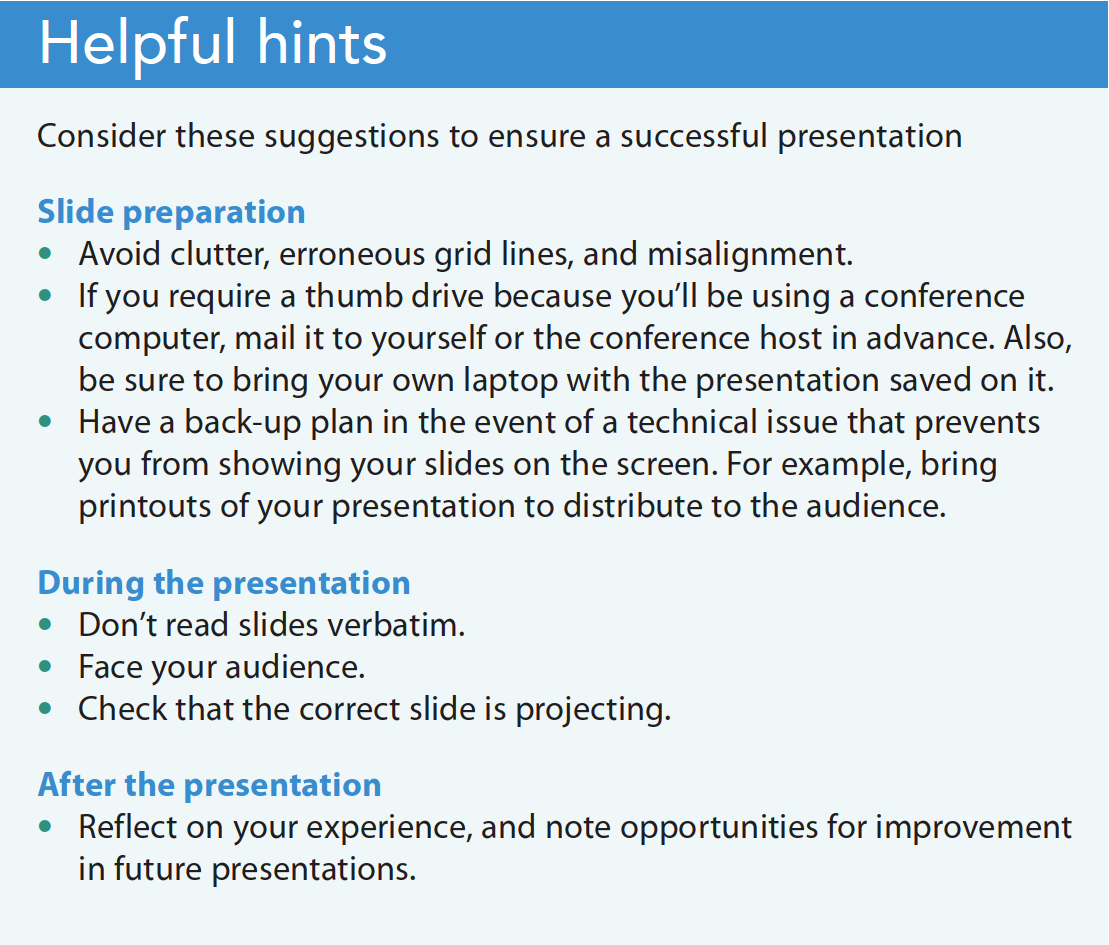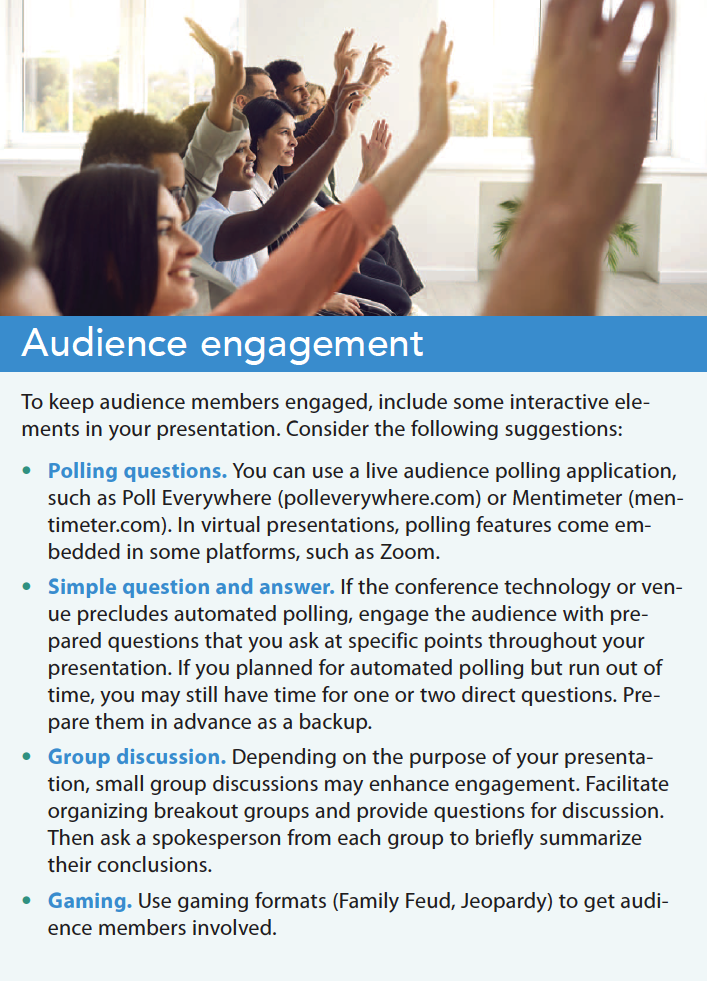Preparation and engagement
- Presentation preparation requires organization, slide preparation, familiarity for technology, and practice.
- Know your audience and engage them using appropriate strategies.
- Plan for a powerful opening and a memorable ending.
Your professional organization has accepted your abstract for an oral presentation. Now what? How do you prepare? The following tips will help ensure an organized presentation that engages your audience. (See Helpful hints.)
Get organized
Organizing your presentation includes creating an outline and preparing your slides.
Outline
Create a presentation outline. Start with the major points, and then add subthemes. Keep in mind how much time you have to speak (you could have as few as 10 minutes or as long as an hour), and determine how much time you want to devote to each section. Here’s a sample presentation focused on professional advancement in nursing:
- Overview: Career Planning and Development
- Self-Assessment
- Personal SWOT Analysis (Strengths, Weaknesses, Opportunities, and Threats)
- Curriculum Vitae Review
- Professional Roadmap
Slide structure
Slides help your audience understand and follow your content. Your first slide should include the presentation title, your name and credentials, and organization, as well as any other details required by the meeting organizer. Sequence the remaining slides based on the type of information you’re disseminating (original research, quality improvement [QI], innovation). For original research and QI projects, use the IMRaD approach:
- Introduction (Use brief bullet points to show the significance or aim.)
- Methods (For a research study, describe the study design; for a QI project, describe the methodology used: Plan-Do-Study-Act, Lean/Six Sigma, Root Cause Analysis.)
- Results (Use graphs and tables, include participant characteristics and highlights of descriptive and analytic results.)
- Discussion (Interpret findings—how are they similar or different from existing evidence—study limitations, conclusions, recommendations.)
If you’re presenting on an innovation, organize slides into three sections: the need for the innovation (Why was it needed? What value does it have for stakeholders?), the innovation itself (What is the the new product, device, or process?), and the outcomes and implications (What’s the impact to the end user and the organization?).
You may be invited to speak on a specific topic related to conference objectives, such as improving patient care through nursing engagement or the nurse’s role in patient safety. Using a logical format, organize your presentation according to the key messages.
Slide creation
Now that you’ve determined the flow of your presentation, you’re ready to create the slides. Think about the amount of text per slide, the font size and colors, and the background.
Use phrases or key points rather than full sentences on each slide. In addition to serving as a more effective visual, this format prevents you from reading slide content word for word. On average, presenters spend 2 to 3 minutes on each slide, so plan content length with this in mind. Some experts recommend the 2-4-8 rule: Every 2 minutes move to a new slide, with no more than 4 bullet points per slide, and no more than 8 words per bullet. Others recommend the 5×5 rule: no more than 5 words per line of text and 5 lines of text per slide.
Use an easy-to-read sans serif font, such as Arial or Helvetica, and remember the 36-28-28 rule for font sizes: 36-point title, 28-point heading, and 28-point subheading. If necessary, 24-point fonts also are acceptable. The font color should enhance readability, especially from a distance. For the background, use a neutral color. Many consider blue most effective. You want to keep it clean, professional, and uncluttered.
If possible, visit the presentation room early so you can assess the lighting. Be prepared to make adjustments if necessary. If you have a good amount of ambient light, dark text on a light background works best; the opposite (light text on a dark background) is true if you have low light.
Before your presentation
Whether this is your first or forty-first presentation, devote time to practice. Rehearsing allows you to catch errors and take advantage of opportunities for improvement. Practice your delivery and plan for a powerful opening. You can start and end with a meaningful and memorable story or ask a reflective question. Schedule a dry run with a family member or friend—request feedback and ask them to repeat key points to check presentation clarity. Another practice session with a trusted colleague who has good critical thinking skills can help ensure precise execution.
Choose professional attire that’s comfortable and promotes self-confidence. Audience members will note your appearance—it’s the first thing they’ll see before you begin your presentation.
Arrive for the presentation early. Most conferences have a speaker room where you can prepare before the presentation. If not, go straight to the presentation venue. Upon arrival, introduce yourself to the moderator, then test the microphone, video, and any web-based applications. If you encounter issues, notify the moderator or information technology personnel immediately.
This may seem obvious, but be sure to use the restroom before the presentation begins (especially if it’s 30 minutes or more). Also, make sure you have water on stage with you. The conference may provide this for you, but if not, bring your own.
The big day
Look at your audience, smile, and begin your presentation. Speak clearly and loudly enough for attendees in the last row to hear. Look around the room as you speak; don’t focus on one individual or section. Be confident in your delivery, and remember that you know what you’re talking about. If you’re presenting a research study, you’re probably the primary investigator or co-investigator, so that means you’ve mastered the content. If you’re presenting on a special topic, chances are you’re a subject matter expert.
If you encounter a heckler, address their questions to the best of your ability. If you don’t have the information, feel yourself getting flustered or frustrated, or the person is dominating the presentation, thank them for their level of engagement and that you look forward to speaking with them more after the presentation. Remain courteous, gracious, and appreciative.
Most presentations end with a question-and-answer session. Listen to each person’s entire question so you can understand the context. Repeat the question to make sure everyone heard it. If appropriate, engage with the audience by asking, “How about you?” or “What do you think?” If you want, provide your email address for any follow-up questions. After the presentation, stay in the room or close to the exit to network with audience members. (See Audience engagement.)
Wrap it up
After the presentation, take 10 minutes (set a timer) to think about what you might improve or do differently. After the timer goes off, think only of the positives and own your success. Make constructive notes that you can use later to ensure that you continue to improve. Dwelling on what didn’t go well only serves to undermine your confidence and has no place in your journey to being a master presenter.
Stay in touch with the organizer. They’ll reach out to you for any post-event needs, to share evaluation results, and forward any questions they received about your presentation.
Presenting to a live audience involves extensive preparation, but it’s a rewarding experience. Consider it an opportunity to build your credentials and to earn recognition as an expert in your field.
Rhoda Redulla is director for nursing excellence/Magnet Recognition at NewYork-Presbyterian in New York, New York, associate editor of Gastroenterology Nursing, and editor of Fast Facts for Making the Most of Your Career in Nursing.
References
Alexandrov AV, Hennerici MG. How to prepare and deliver a scientific presentation. Cerebrovasc Dis. 2013;35(3):202-8. doi:10.1159/000346077
Association of Research Libraries. PowerPoint guidelines for presenters. arl.org/accessibility-guidelines-for-powerpoint-presentations/
Sherman R. Writing for presentations. In: Saver C, ed. Anatomy of Writing for Publications for Nurses. 4th ed. Indianapolis, IN: Sigma; 2021; 222.
Key words: oral presentations, podium presentations, audience engagement




















